
Cheque for 50,000,000 Polish marks - a template
1923
National Museum in Lublin
Part of the collection: Paper money during the Second Polish Republic
5000 mkp is the highest denomination from the popular series of Polish paper money of the interwar period, from 23 August 1919 - from 1 to 1000 mkp, and from 7 February 1920 - 0.5 and 5000 mkp. It is distinguished by its Art Nouveau graphic design with rich floral motifs and wavy line, it was designed in the Vienna State Printing House. The 5000 mkp banknote was printed at the Vienna State Printing House and at the State Graphic Works in Warsaw and other private printing works in the capital city. The issuing institution was the Polish National Loan Bank (PKKP), established by the German occupier and polonized in 1918, which was to serve as the central financial institution of the country until the establishment of the Bank of Poland and the national currency.
At the time of the introduction of the 5,000 mkp into circulation (25 February 1920), the mkp already had the status of exclusive legal tender in the area of the former Prussian partition, a month later (24 March) it gained that status in Galicia, and a few weeks later in parts of the former Russian partition. The fact that the mkp was replacing the currencies of the partitioning states made it necessary to print banknotes, which were not backed by gold and therefore lost value. Prices were therefore rising. During the first weeks of 1920, the mkp depreciated against the dollar by 42%. At that time the issue of "Kurier Warszawski" rose from 0.3 to 0.5 mkp. The demand for higher denominations was increasing. While a 1000 mkp banknote was still sufficient at the end of 1919, less than three months later it was decided to introduce a 5000 mkp currency. By the end of February 1920, it was equivalent to a six-month tramway subscription, to which an additional fee of 188.5 mkp was added. We can guess that the surcharge was to compensate for possible losses of the transport company caused by inflation.
While other banknotes of the Vienna series are alternately decorated with images of Tadeusz Kościuszko (†1817) according to a portrait by Józef Grassi and Queen Jadwiga (†1399) from a painting by Jan Matejko, on the 5000 mkp these figures were juxtaposed. It is also worth knowing that this banknote is the largest Polish paper money in terms of size. There are differences in the dimensions of its individual pieces - ours measures 143 x 224 mm.
The banknote was protected against counterfeiting by a watermark in the form of a grid of squares with rounded corners.
Tomasz Markiewicz
Author / creator
Dimensions
cały obiekt: height: 224 mm, width: 143 mm
Object type
paper money
Technique
Material
paper
Creation time / dating
Creation / finding place
Owner
The National Museum in Lublin
Identification number
Location / status

1923
National Museum in Lublin

1923
National Museum in Lublin

1923
National Museum in Lublin
DISCOVER this TOPIC
Castle Museum in Łańcut
DISCOVER this PATH
Educational path